Employment Law Analysis: Bob's Dismissal & Employment Status at RSL
VerifiedAdded on 2023/04/23
|8
|1955
|269
Case Study
AI Summary
This case study analyzes the employment law issues surrounding Bob's situation at the RSL club. Initially employed as a part-time sommelier, Bob was later asked to obtain an ABN and invoice for his work, leading to the question of whether he transitioned to a contractor role or remained an employee. The analysis applies the multi-factor test to determine his employment status, focusing on control, exclusivity, and delegation. Furthermore, the case examines the binding nature of the club's Code of Conduct on Bob and whether the club had valid grounds for his dismissal following allegations of sexually inappropriate comments and bullying towards a co-worker. The study references relevant legal precedents and the Fair Work Act 2009 to assess the fairness and validity of Bob's dismissal, ultimately concluding whether the club's actions were justified based on the evidence and applicable employment laws. Desklib offers a wide range of resources, including similar case studies and solved assignments, to aid students in their studies.
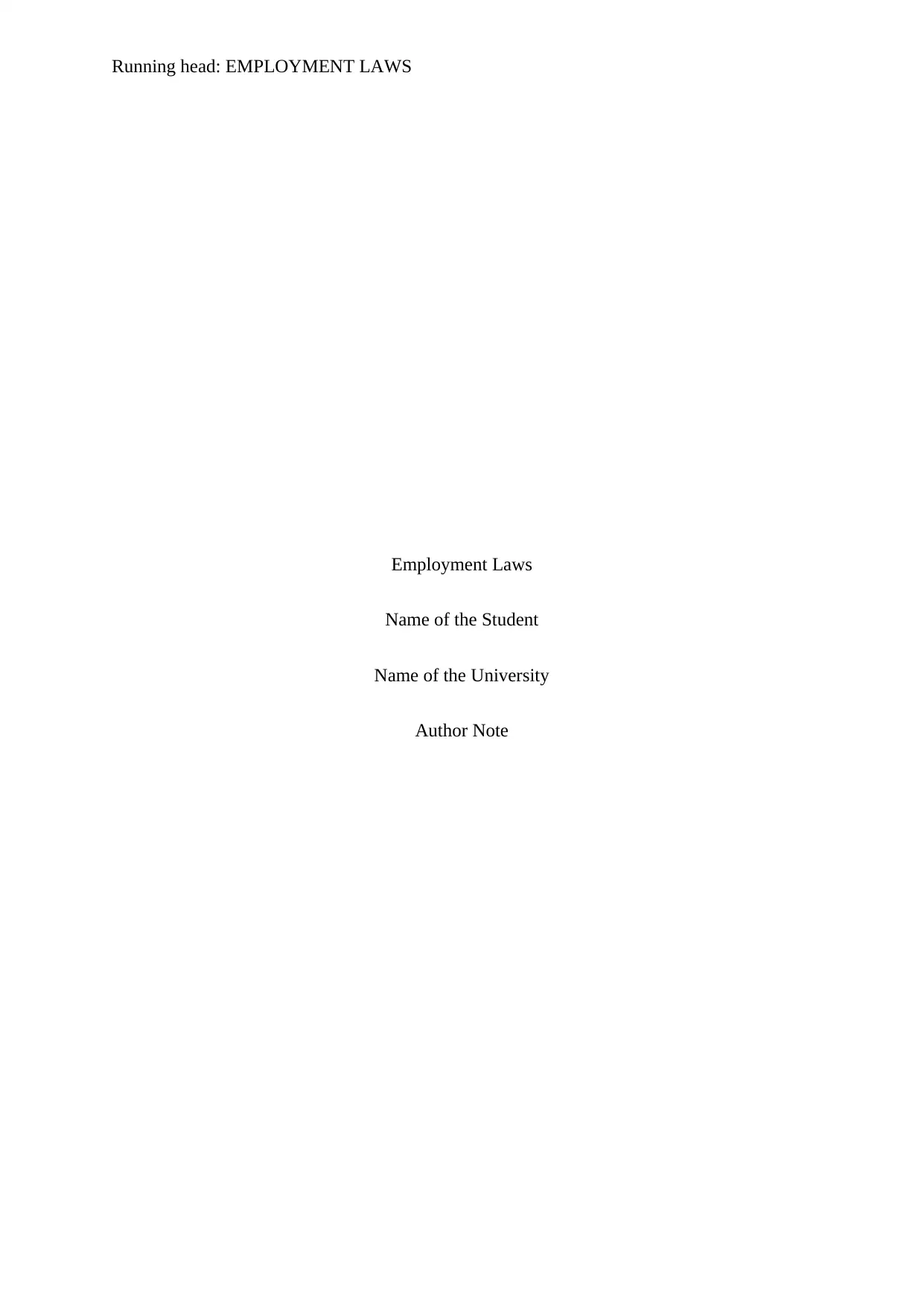
Running head: EMPLOYMENT LAWS
Employment Laws
Name of the Student
Name of the University
Author Note
Employment Laws
Name of the Student
Name of the University
Author Note
Paraphrase This Document
Need a fresh take? Get an instant paraphrase of this document with our AI Paraphraser
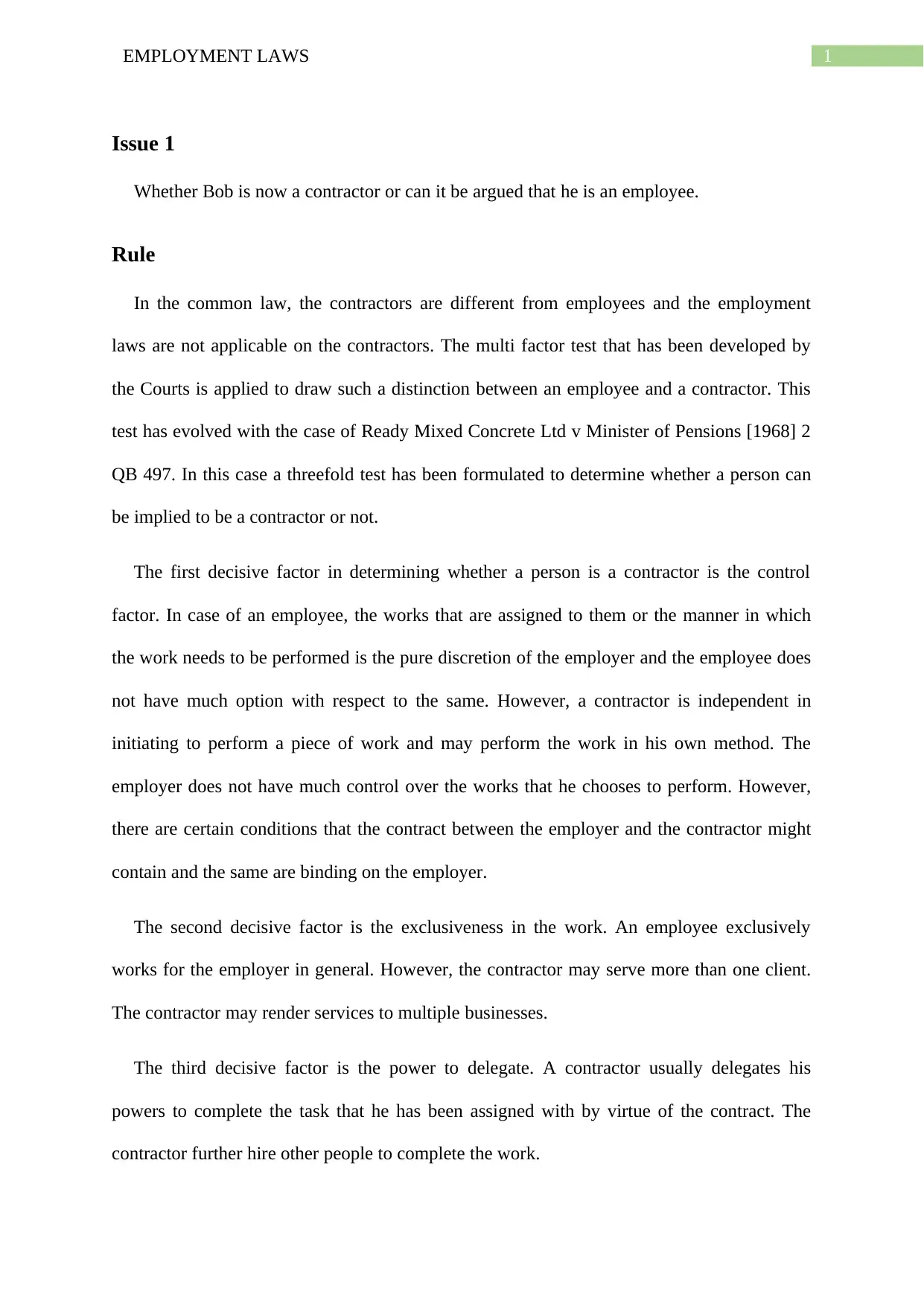
1EMPLOYMENT LAWS
Issue 1
Whether Bob is now a contractor or can it be argued that he is an employee.
Rule
In the common law, the contractors are different from employees and the employment
laws are not applicable on the contractors. The multi factor test that has been developed by
the Courts is applied to draw such a distinction between an employee and a contractor. This
test has evolved with the case of Ready Mixed Concrete Ltd v Minister of Pensions [1968] 2
QB 497. In this case a threefold test has been formulated to determine whether a person can
be implied to be a contractor or not.
The first decisive factor in determining whether a person is a contractor is the control
factor. In case of an employee, the works that are assigned to them or the manner in which
the work needs to be performed is the pure discretion of the employer and the employee does
not have much option with respect to the same. However, a contractor is independent in
initiating to perform a piece of work and may perform the work in his own method. The
employer does not have much control over the works that he chooses to perform. However,
there are certain conditions that the contract between the employer and the contractor might
contain and the same are binding on the employer.
The second decisive factor is the exclusiveness in the work. An employee exclusively
works for the employer in general. However, the contractor may serve more than one client.
The contractor may render services to multiple businesses.
The third decisive factor is the power to delegate. A contractor usually delegates his
powers to complete the task that he has been assigned with by virtue of the contract. The
contractor further hire other people to complete the work.
Issue 1
Whether Bob is now a contractor or can it be argued that he is an employee.
Rule
In the common law, the contractors are different from employees and the employment
laws are not applicable on the contractors. The multi factor test that has been developed by
the Courts is applied to draw such a distinction between an employee and a contractor. This
test has evolved with the case of Ready Mixed Concrete Ltd v Minister of Pensions [1968] 2
QB 497. In this case a threefold test has been formulated to determine whether a person can
be implied to be a contractor or not.
The first decisive factor in determining whether a person is a contractor is the control
factor. In case of an employee, the works that are assigned to them or the manner in which
the work needs to be performed is the pure discretion of the employer and the employee does
not have much option with respect to the same. However, a contractor is independent in
initiating to perform a piece of work and may perform the work in his own method. The
employer does not have much control over the works that he chooses to perform. However,
there are certain conditions that the contract between the employer and the contractor might
contain and the same are binding on the employer.
The second decisive factor is the exclusiveness in the work. An employee exclusively
works for the employer in general. However, the contractor may serve more than one client.
The contractor may render services to multiple businesses.
The third decisive factor is the power to delegate. A contractor usually delegates his
powers to complete the task that he has been assigned with by virtue of the contract. The
contractor further hire other people to complete the work.
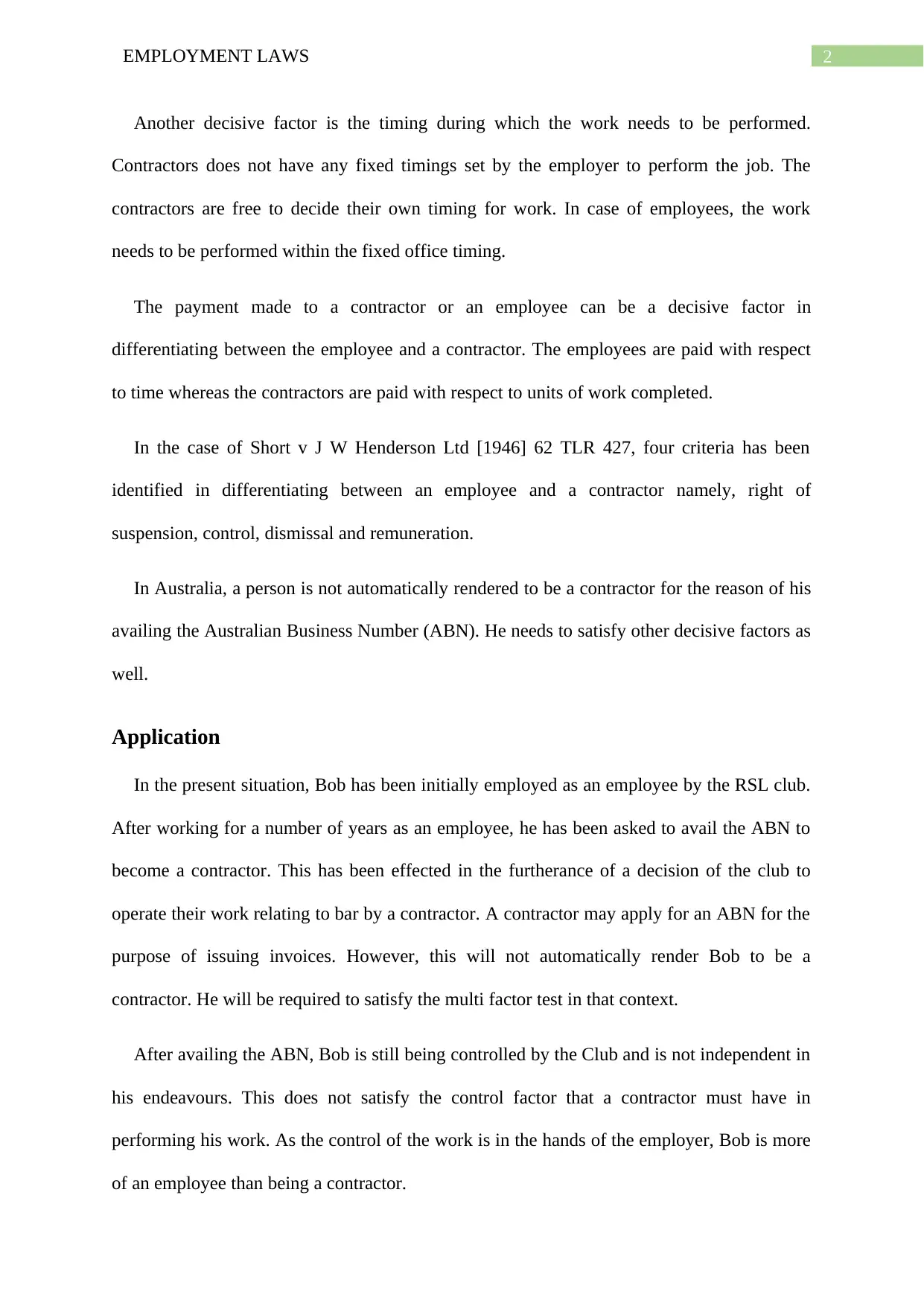
2EMPLOYMENT LAWS
Another decisive factor is the timing during which the work needs to be performed.
Contractors does not have any fixed timings set by the employer to perform the job. The
contractors are free to decide their own timing for work. In case of employees, the work
needs to be performed within the fixed office timing.
The payment made to a contractor or an employee can be a decisive factor in
differentiating between the employee and a contractor. The employees are paid with respect
to time whereas the contractors are paid with respect to units of work completed.
In the case of Short v J W Henderson Ltd [1946] 62 TLR 427, four criteria has been
identified in differentiating between an employee and a contractor namely, right of
suspension, control, dismissal and remuneration.
In Australia, a person is not automatically rendered to be a contractor for the reason of his
availing the Australian Business Number (ABN). He needs to satisfy other decisive factors as
well.
Application
In the present situation, Bob has been initially employed as an employee by the RSL club.
After working for a number of years as an employee, he has been asked to avail the ABN to
become a contractor. This has been effected in the furtherance of a decision of the club to
operate their work relating to bar by a contractor. A contractor may apply for an ABN for the
purpose of issuing invoices. However, this will not automatically render Bob to be a
contractor. He will be required to satisfy the multi factor test in that context.
After availing the ABN, Bob is still being controlled by the Club and is not independent in
his endeavours. This does not satisfy the control factor that a contractor must have in
performing his work. As the control of the work is in the hands of the employer, Bob is more
of an employee than being a contractor.
Another decisive factor is the timing during which the work needs to be performed.
Contractors does not have any fixed timings set by the employer to perform the job. The
contractors are free to decide their own timing for work. In case of employees, the work
needs to be performed within the fixed office timing.
The payment made to a contractor or an employee can be a decisive factor in
differentiating between the employee and a contractor. The employees are paid with respect
to time whereas the contractors are paid with respect to units of work completed.
In the case of Short v J W Henderson Ltd [1946] 62 TLR 427, four criteria has been
identified in differentiating between an employee and a contractor namely, right of
suspension, control, dismissal and remuneration.
In Australia, a person is not automatically rendered to be a contractor for the reason of his
availing the Australian Business Number (ABN). He needs to satisfy other decisive factors as
well.
Application
In the present situation, Bob has been initially employed as an employee by the RSL club.
After working for a number of years as an employee, he has been asked to avail the ABN to
become a contractor. This has been effected in the furtherance of a decision of the club to
operate their work relating to bar by a contractor. A contractor may apply for an ABN for the
purpose of issuing invoices. However, this will not automatically render Bob to be a
contractor. He will be required to satisfy the multi factor test in that context.
After availing the ABN, Bob is still being controlled by the Club and is not independent in
his endeavours. This does not satisfy the control factor that a contractor must have in
performing his work. As the control of the work is in the hands of the employer, Bob is more
of an employee than being a contractor.
⊘ This is a preview!⊘
Do you want full access?
Subscribe today to unlock all pages.

Trusted by 1+ million students worldwide
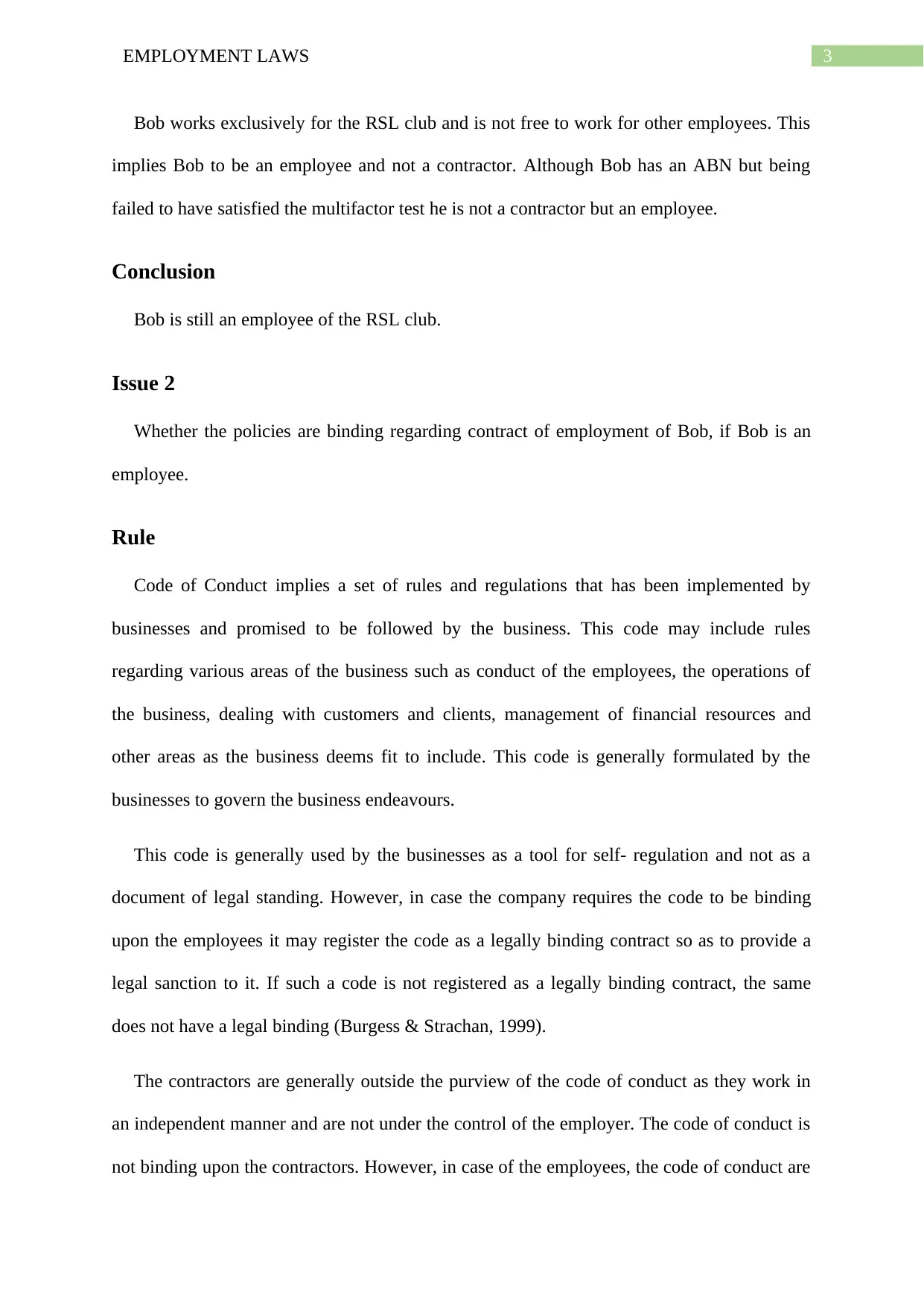
3EMPLOYMENT LAWS
Bob works exclusively for the RSL club and is not free to work for other employees. This
implies Bob to be an employee and not a contractor. Although Bob has an ABN but being
failed to have satisfied the multifactor test he is not a contractor but an employee.
Conclusion
Bob is still an employee of the RSL club.
Issue 2
Whether the policies are binding regarding contract of employment of Bob, if Bob is an
employee.
Rule
Code of Conduct implies a set of rules and regulations that has been implemented by
businesses and promised to be followed by the business. This code may include rules
regarding various areas of the business such as conduct of the employees, the operations of
the business, dealing with customers and clients, management of financial resources and
other areas as the business deems fit to include. This code is generally formulated by the
businesses to govern the business endeavours.
This code is generally used by the businesses as a tool for self- regulation and not as a
document of legal standing. However, in case the company requires the code to be binding
upon the employees it may register the code as a legally binding contract so as to provide a
legal sanction to it. If such a code is not registered as a legally binding contract, the same
does not have a legal binding (Burgess & Strachan, 1999).
The contractors are generally outside the purview of the code of conduct as they work in
an independent manner and are not under the control of the employer. The code of conduct is
not binding upon the contractors. However, in case of the employees, the code of conduct are
Bob works exclusively for the RSL club and is not free to work for other employees. This
implies Bob to be an employee and not a contractor. Although Bob has an ABN but being
failed to have satisfied the multifactor test he is not a contractor but an employee.
Conclusion
Bob is still an employee of the RSL club.
Issue 2
Whether the policies are binding regarding contract of employment of Bob, if Bob is an
employee.
Rule
Code of Conduct implies a set of rules and regulations that has been implemented by
businesses and promised to be followed by the business. This code may include rules
regarding various areas of the business such as conduct of the employees, the operations of
the business, dealing with customers and clients, management of financial resources and
other areas as the business deems fit to include. This code is generally formulated by the
businesses to govern the business endeavours.
This code is generally used by the businesses as a tool for self- regulation and not as a
document of legal standing. However, in case the company requires the code to be binding
upon the employees it may register the code as a legally binding contract so as to provide a
legal sanction to it. If such a code is not registered as a legally binding contract, the same
does not have a legal binding (Burgess & Strachan, 1999).
The contractors are generally outside the purview of the code of conduct as they work in
an independent manner and are not under the control of the employer. The code of conduct is
not binding upon the contractors. However, in case of the employees, the code of conduct are
Paraphrase This Document
Need a fresh take? Get an instant paraphrase of this document with our AI Paraphraser
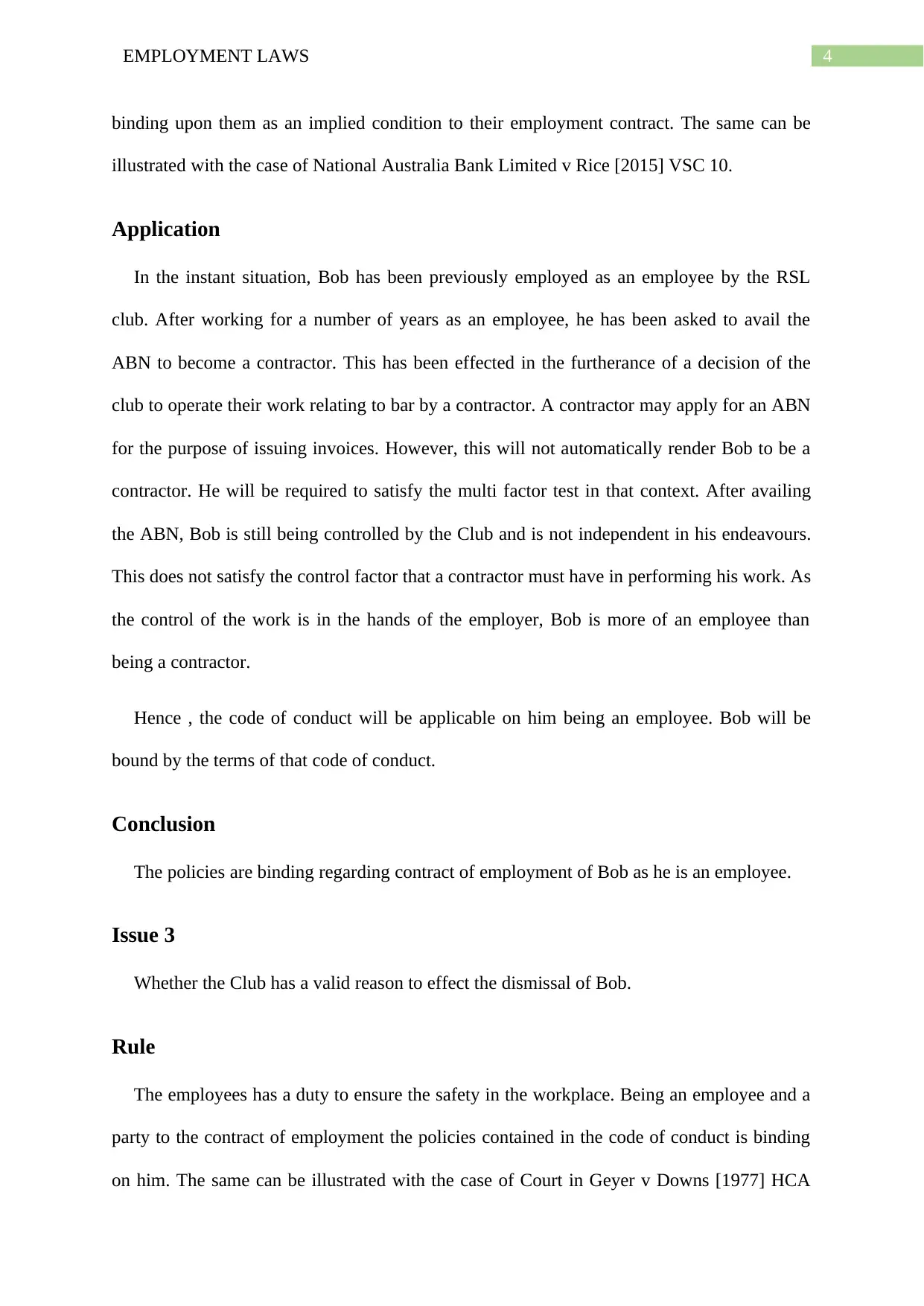
4EMPLOYMENT LAWS
binding upon them as an implied condition to their employment contract. The same can be
illustrated with the case of National Australia Bank Limited v Rice [2015] VSC 10.
Application
In the instant situation, Bob has been previously employed as an employee by the RSL
club. After working for a number of years as an employee, he has been asked to avail the
ABN to become a contractor. This has been effected in the furtherance of a decision of the
club to operate their work relating to bar by a contractor. A contractor may apply for an ABN
for the purpose of issuing invoices. However, this will not automatically render Bob to be a
contractor. He will be required to satisfy the multi factor test in that context. After availing
the ABN, Bob is still being controlled by the Club and is not independent in his endeavours.
This does not satisfy the control factor that a contractor must have in performing his work. As
the control of the work is in the hands of the employer, Bob is more of an employee than
being a contractor.
Hence , the code of conduct will be applicable on him being an employee. Bob will be
bound by the terms of that code of conduct.
Conclusion
The policies are binding regarding contract of employment of Bob as he is an employee.
Issue 3
Whether the Club has a valid reason to effect the dismissal of Bob.
Rule
The employees has a duty to ensure the safety in the workplace. Being an employee and a
party to the contract of employment the policies contained in the code of conduct is binding
on him. The same can be illustrated with the case of Court in Geyer v Downs [1977] HCA
binding upon them as an implied condition to their employment contract. The same can be
illustrated with the case of National Australia Bank Limited v Rice [2015] VSC 10.
Application
In the instant situation, Bob has been previously employed as an employee by the RSL
club. After working for a number of years as an employee, he has been asked to avail the
ABN to become a contractor. This has been effected in the furtherance of a decision of the
club to operate their work relating to bar by a contractor. A contractor may apply for an ABN
for the purpose of issuing invoices. However, this will not automatically render Bob to be a
contractor. He will be required to satisfy the multi factor test in that context. After availing
the ABN, Bob is still being controlled by the Club and is not independent in his endeavours.
This does not satisfy the control factor that a contractor must have in performing his work. As
the control of the work is in the hands of the employer, Bob is more of an employee than
being a contractor.
Hence , the code of conduct will be applicable on him being an employee. Bob will be
bound by the terms of that code of conduct.
Conclusion
The policies are binding regarding contract of employment of Bob as he is an employee.
Issue 3
Whether the Club has a valid reason to effect the dismissal of Bob.
Rule
The employees has a duty to ensure the safety in the workplace. Being an employee and a
party to the contract of employment the policies contained in the code of conduct is binding
on him. The same can be illustrated with the case of Court in Geyer v Downs [1977] HCA
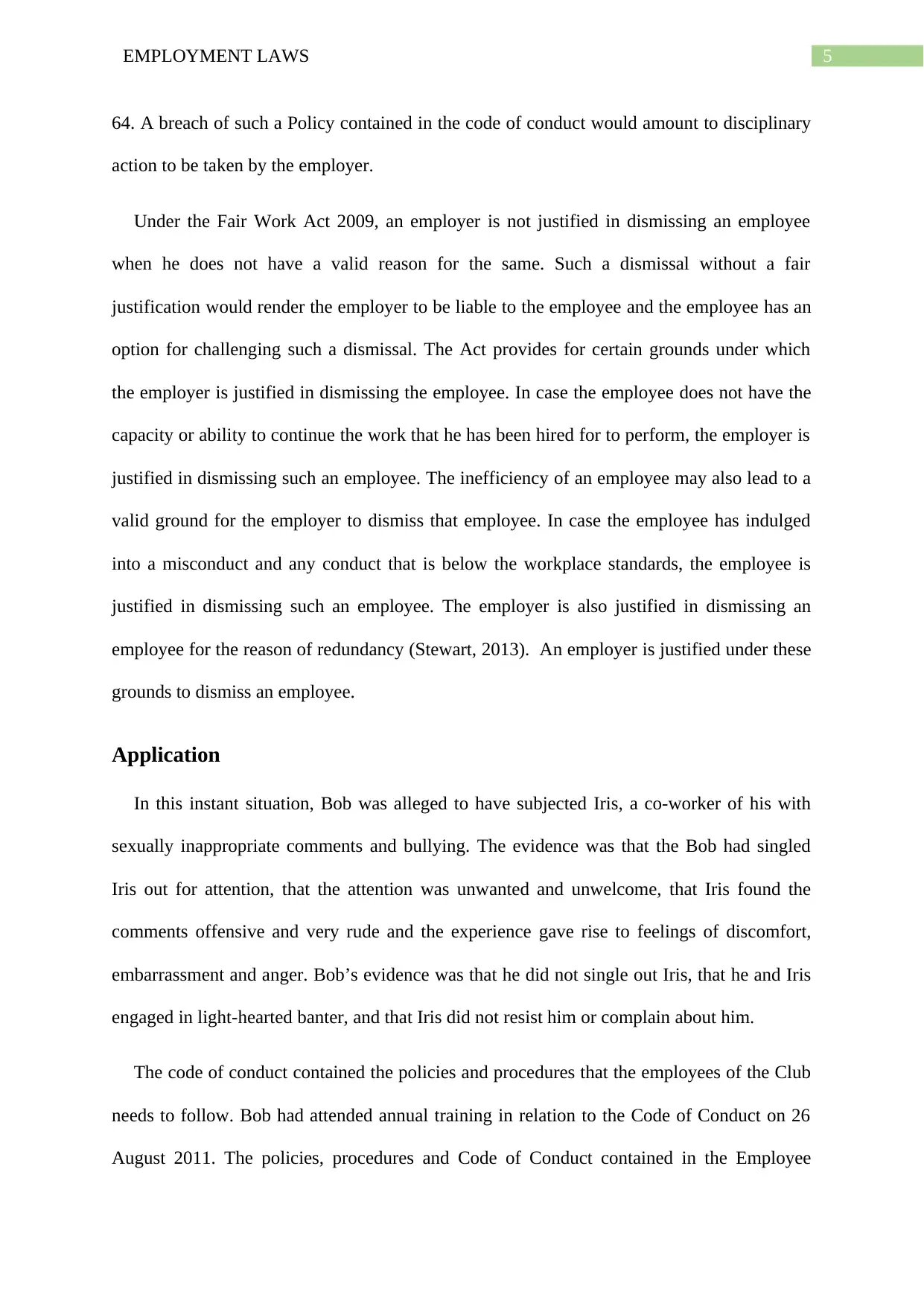
5EMPLOYMENT LAWS
64. A breach of such a Policy contained in the code of conduct would amount to disciplinary
action to be taken by the employer.
Under the Fair Work Act 2009, an employer is not justified in dismissing an employee
when he does not have a valid reason for the same. Such a dismissal without a fair
justification would render the employer to be liable to the employee and the employee has an
option for challenging such a dismissal. The Act provides for certain grounds under which
the employer is justified in dismissing the employee. In case the employee does not have the
capacity or ability to continue the work that he has been hired for to perform, the employer is
justified in dismissing such an employee. The inefficiency of an employee may also lead to a
valid ground for the employer to dismiss that employee. In case the employee has indulged
into a misconduct and any conduct that is below the workplace standards, the employee is
justified in dismissing such an employee. The employer is also justified in dismissing an
employee for the reason of redundancy (Stewart, 2013). An employer is justified under these
grounds to dismiss an employee.
Application
In this instant situation, Bob was alleged to have subjected Iris, a co-worker of his with
sexually inappropriate comments and bullying. The evidence was that the Bob had singled
Iris out for attention, that the attention was unwanted and unwelcome, that Iris found the
comments offensive and very rude and the experience gave rise to feelings of discomfort,
embarrassment and anger. Bob’s evidence was that he did not single out Iris, that he and Iris
engaged in light-hearted banter, and that Iris did not resist him or complain about him.
The code of conduct contained the policies and procedures that the employees of the Club
needs to follow. Bob had attended annual training in relation to the Code of Conduct on 26
August 2011. The policies, procedures and Code of Conduct contained in the Employee
64. A breach of such a Policy contained in the code of conduct would amount to disciplinary
action to be taken by the employer.
Under the Fair Work Act 2009, an employer is not justified in dismissing an employee
when he does not have a valid reason for the same. Such a dismissal without a fair
justification would render the employer to be liable to the employee and the employee has an
option for challenging such a dismissal. The Act provides for certain grounds under which
the employer is justified in dismissing the employee. In case the employee does not have the
capacity or ability to continue the work that he has been hired for to perform, the employer is
justified in dismissing such an employee. The inefficiency of an employee may also lead to a
valid ground for the employer to dismiss that employee. In case the employee has indulged
into a misconduct and any conduct that is below the workplace standards, the employee is
justified in dismissing such an employee. The employer is also justified in dismissing an
employee for the reason of redundancy (Stewart, 2013). An employer is justified under these
grounds to dismiss an employee.
Application
In this instant situation, Bob was alleged to have subjected Iris, a co-worker of his with
sexually inappropriate comments and bullying. The evidence was that the Bob had singled
Iris out for attention, that the attention was unwanted and unwelcome, that Iris found the
comments offensive and very rude and the experience gave rise to feelings of discomfort,
embarrassment and anger. Bob’s evidence was that he did not single out Iris, that he and Iris
engaged in light-hearted banter, and that Iris did not resist him or complain about him.
The code of conduct contained the policies and procedures that the employees of the Club
needs to follow. Bob had attended annual training in relation to the Code of Conduct on 26
August 2011. The policies, procedures and Code of Conduct contained in the Employee
⊘ This is a preview!⊘
Do you want full access?
Subscribe today to unlock all pages.

Trusted by 1+ million students worldwide
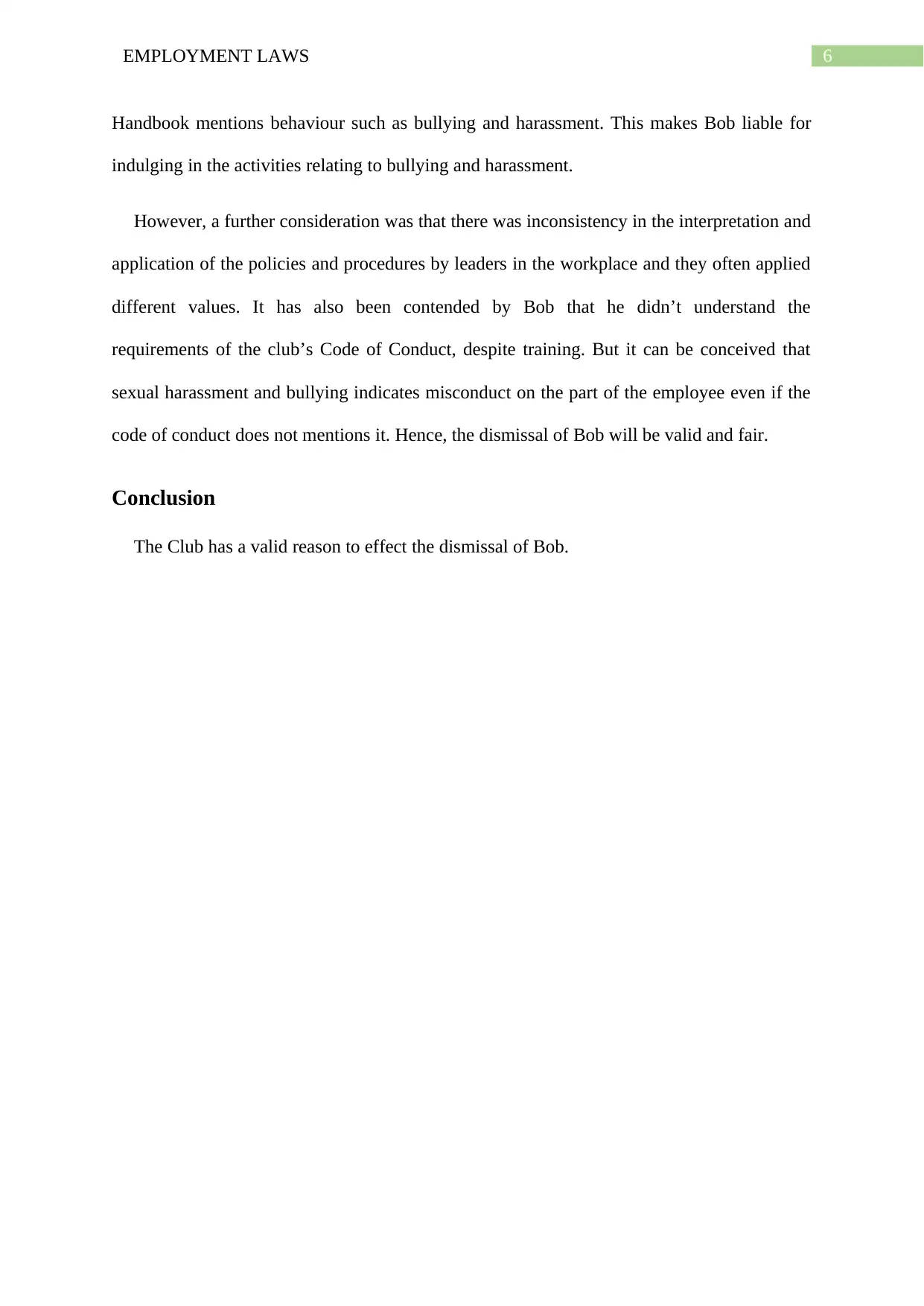
6EMPLOYMENT LAWS
Handbook mentions behaviour such as bullying and harassment. This makes Bob liable for
indulging in the activities relating to bullying and harassment.
However, a further consideration was that there was inconsistency in the interpretation and
application of the policies and procedures by leaders in the workplace and they often applied
different values. It has also been contended by Bob that he didn’t understand the
requirements of the club’s Code of Conduct, despite training. But it can be conceived that
sexual harassment and bullying indicates misconduct on the part of the employee even if the
code of conduct does not mentions it. Hence, the dismissal of Bob will be valid and fair.
Conclusion
The Club has a valid reason to effect the dismissal of Bob.
Handbook mentions behaviour such as bullying and harassment. This makes Bob liable for
indulging in the activities relating to bullying and harassment.
However, a further consideration was that there was inconsistency in the interpretation and
application of the policies and procedures by leaders in the workplace and they often applied
different values. It has also been contended by Bob that he didn’t understand the
requirements of the club’s Code of Conduct, despite training. But it can be conceived that
sexual harassment and bullying indicates misconduct on the part of the employee even if the
code of conduct does not mentions it. Hence, the dismissal of Bob will be valid and fair.
Conclusion
The Club has a valid reason to effect the dismissal of Bob.
Paraphrase This Document
Need a fresh take? Get an instant paraphrase of this document with our AI Paraphraser
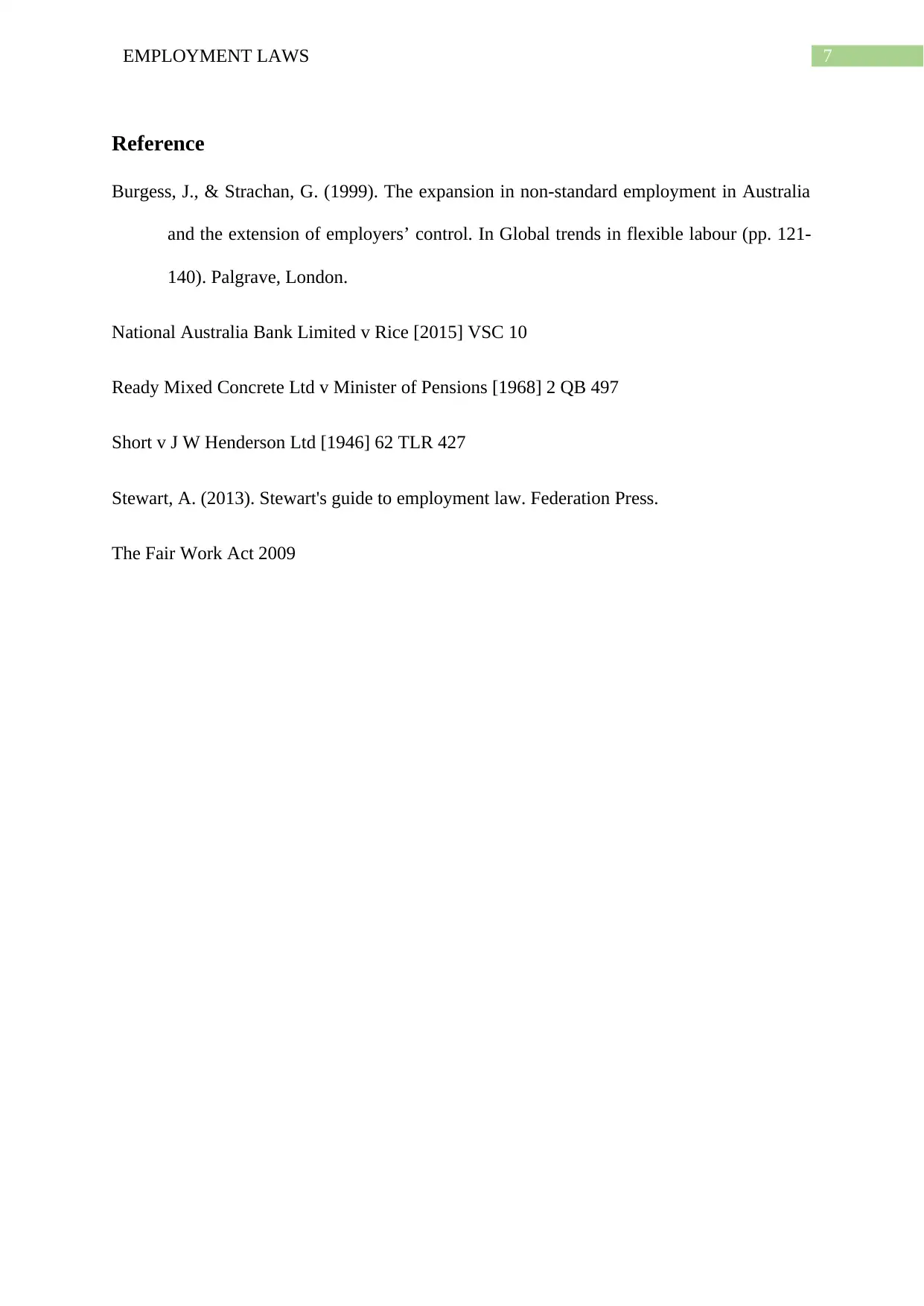
7EMPLOYMENT LAWS
Reference
Burgess, J., & Strachan, G. (1999). The expansion in non-standard employment in Australia
and the extension of employers’ control. In Global trends in flexible labour (pp. 121-
140). Palgrave, London.
National Australia Bank Limited v Rice [2015] VSC 10
Ready Mixed Concrete Ltd v Minister of Pensions [1968] 2 QB 497
Short v J W Henderson Ltd [1946] 62 TLR 427
Stewart, A. (2013). Stewart's guide to employment law. Federation Press.
The Fair Work Act 2009
Reference
Burgess, J., & Strachan, G. (1999). The expansion in non-standard employment in Australia
and the extension of employers’ control. In Global trends in flexible labour (pp. 121-
140). Palgrave, London.
National Australia Bank Limited v Rice [2015] VSC 10
Ready Mixed Concrete Ltd v Minister of Pensions [1968] 2 QB 497
Short v J W Henderson Ltd [1946] 62 TLR 427
Stewart, A. (2013). Stewart's guide to employment law. Federation Press.
The Fair Work Act 2009
1 out of 8
Related Documents
Your All-in-One AI-Powered Toolkit for Academic Success.
+13062052269
info@desklib.com
Available 24*7 on WhatsApp / Email
![[object Object]](/_next/static/media/star-bottom.7253800d.svg)
Unlock your academic potential
Copyright © 2020–2025 A2Z Services. All Rights Reserved. Developed and managed by ZUCOL.





